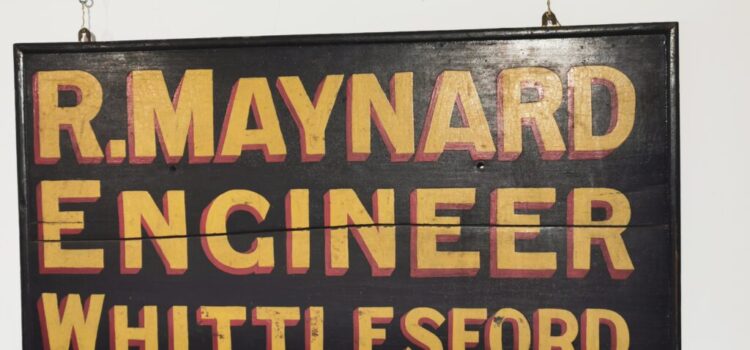Hanging behind the reception counter at the Museum of Cambridge is the unmissable sign,
R.MAYNARD
ENGINEER
WHITTLESFORD
Who was he? Well, it was a Robert Maynard who in 1834 set up a foundry making agricultural implements on Whittlesford High Street. In 1861 he employed 30 men; after his death, his son, also Robert, carried on the business. Finally, after the death of the grandson R J Maynard, the business closed in the mid 1950s.
But we now know quite a lot more about the Maynards and people of Whittlesford and the surrounding villages than we did. Robert Maynard was clearly an enlightened employer and in 1866 started up a Working Man’s Institute with a lecture hall, reading and bagatelle rooms. The 1861 census also records him as a farmer of 100 acres.
He is not the only Maynard in Whittlesford and this is where the diary of grocer William Farrington becomes so interesting. Unlike the diary of Josiah Chater which we are in the process of transcribing for the first time, thanks to a team of dedicated volunteers, the diary of William Farrington, which we also hold, was transcribed many years ago, but was until now unpublished. It paints a detailed picture of life in Whittlesford, Duxford and surrounding villages during the period 1858 – 1862.
We owe an enormous debt to to the work of Fiona Fitzgibbon who twenty years ago started work on the process of transcribing these diaries. Only now we can share with you the labours of her work, the transcriptions as well as the appendices she worked on.
We can now use Capturingcambridge.org to show where the characters and places mentioned in the diary were situated as well as make available an annotated version of the transcription.
When the diary starts, William Farrington is working for Nathan Maynard, the grocer in South Street (now probably High Street) Whittlesford. In 1861 William married Nathan’s daughter, Sarah Anne, and moved to set up shop in St Peter’s Street Duxford. During the diary we are introduced to a whole web of contacts stretching across the villages of southern Cambridgeshire and beyond. The grocers and drapers all seem to know each other. There are the clergy, the doctors, the mill workers and engineers, the agricultural labourers. Some emigrate to Australia; some are killed in train accidents, go mad or have terrible problems with their teeth. They are surprisingly mobile now that the railway has come.
Although we can identify many of these people in the census of 1861 and even in the contemporary newspapers, it is a different matter to actually identify the precise locations where they lived, even with a map such as the 1885 Ordnance Survey edition.
This is why we are looking for those with local historical knowledge of Whittlesford and Duxford who might be able to help us track down the shops, farms and houses where those mentioned in William Farrington’s diary actually lived.
If you would like to help us fill in some of the missing information, please contact us on:
capturingcambridge@museumofcambridge.org.uk
